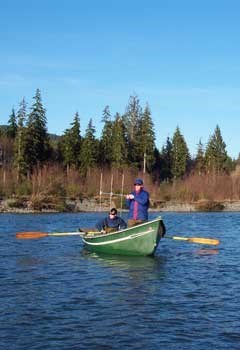
NPS Photo
Background
National Park Service fisheries management is rooted in the Organic Act of 1916 and is reaffirmed by the Redwood National Park Act of 1978. Consistent with these broad authorities, NPS fisheries management policies emphasize sustainability and the preservation and, when necessary, restoration of natural assemblages of native aquatic species and their habitats.
The heritage of the National Park System includes recreational fishing as an activity through which visitors may experience and enjoy aquatic resources. Recreational fishing in NPS units is allowed where it is authorized by federal law or where it is not specifically prohibited and does not interfere with the functions of natural aquatic or riparian habitats. Angling opportunities exist in over 170 NPS units that encompass diverse aquatic environments and fish communities, including numerous species of interest to anglers.
Fishing Regulations and Policies
The NPS has the authority to implement rules and regulations necessary or proper for the use and management of park units. In accordance with the Code of Federal Regulations (36 CFR 2.3), however, sport-fishing regulations in NPS units are generally established in coordination and cooperation with the state(s) within which a park occurs.
Regulations within NPS units should permit reasonable use and enjoyment of resources without compromising the productivity and sustainability of fish populations or the health and biological diversity of the aquatic ecosystems upon which they depend. Areas inside park boundaries may be closed to fishing to protect spawning and nursery areas, threatened and endangered species, non-target fish populations, or other resources that are at risk due to habitat loss or over-fishing.
Fishing tournaments and other competitive fishing events are generally incompatible with NPS resource management goals and objectives. Such events may be permitted only if the activity is clearly authorized within the park unit and will not result in any derogation of the values and purposes for which the park was established.
Commercial fishing in National Park units is allowed only where specifically authorized by federal law or treaty rights. When commercial fishing is authorized, the NPS works with the fishing industry to balance harvest with the health of the aquatic ecosystem. Exploited fish populations must continue to be self-sustaining; and harvest rates, methods, and gear must minimize adverse effects on other natural resources.
Native Fish Restoration
The restoration of depleted native fish stocks and the recovery of threatened and endangered fishes are among the highest priorities for fisheries management in the National Park System. Restoration of native fish populations and communities may involve the control or eradication of nonnative species that have contributed to depletion through predation, hybridization, or competition for limiting resources. Activities to achieve restoration may also include reintroduction to unoccupied habitats, barrier removal or modification, and implementation of special fishing regulations.
Restoring native fish populations is important both because of their value as a recreational resource for visitors and because of the functions they serve in park ecosystems. Many species of terrestrial and aquatic wildlife rely on fish as a food source. Anadromous fish, which grow and mature in the ocean before returning to spawn in freshwater, are critical to the productivity of many aquatic, riparian, and adjacent terrestrial ecosystems.
Many NPS units protect watersheds and aquatic habitats that serve as refuges for healthy populations of native fish species that have declined elsewhere within their ranges. This situation is most typical of parks that are isolated and/or located near the headwaters of large watersheds. In such areas, the protection of habitat is a top priority.
In other areas, habitats have been degraded by activities inside or outside of the park, and the focus is on restoration. Because the factors affecting aquatic habitat often transcend NPS boundaries, habitat restoration is frequently conducted in partnership with states, tribes, other federal agencies, and private entities. Aquatic habitat restoration projects have included improving stream access for salmon and steelhead; recreating cover and woody debris in streams; reestablishing natural stream bed channels and meanders; dam removal, culvert replacements, and stream bank erosion control; and the removal and control of invasive riparian vegetation such as tamarisk.
Fisheries Research
NPS encourages and funds studies in support of the science-based conservation of native fish and sustainable fisheries. Studies of fish population dynamics, community health, aquatic habitat condition, and related areas are funded on a competitive basis through Natural Resource Stewardship and Science.
Some studies are conducted in cooperation with state and other federal partners, universities, or through private contractors. Independent research compatible with NPS policies and objectives is encouraged and managed through a permit system.
Last updated: August 14, 2023
